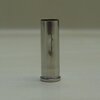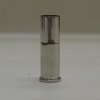Mr_Flintstone
Member
Just an update. I would have reported earlier, but my internet was out. While cleaning my rifle, I got a light into the chamber, and it was indeed dirty; not excessive, but dirty nonetheless, all the way down. I’m guessing with the weakened brass, dirty chamber, and fast powder were too much. I noticed with the Bullseye that the loads, while performing OK, had a loud “Crack” sound instead of the typical “Boom” of .357 magnum. I know that’s not scientific terms, but it’ll have to do. I also had to adjust my rear sight down from where I’d been shooting mid-level .357 magnum, so they were obviously faster than what I’d expected.
Now I know why Alliant no longer lists Bullseye for 125 gr jacketed .357 Magnum.
Looks like it’s back to “Magnum” powders. My favorite is IMR-4227, but lately I’ve been using W296. With it, I get a little better performance with less pressure. I just happened to have Bullseye already in the powder measure, and loaded a few to try them out.
Now I know why Alliant no longer lists Bullseye for 125 gr jacketed .357 Magnum.
Looks like it’s back to “Magnum” powders. My favorite is IMR-4227, but lately I’ve been using W296. With it, I get a little better performance with less pressure. I just happened to have Bullseye already in the powder measure, and loaded a few to try them out.
Last edited:





